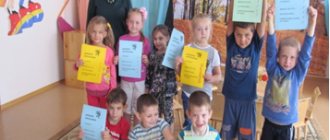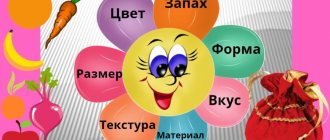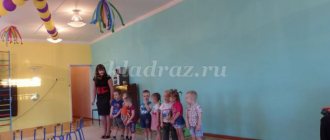Summary of a lesson on speech development in the second junior group
Summary of a lesson on speech development in the second junior group
Author: teacher Trunova Tatyana Yuryevna, MAOU "Spasskaya Secondary School" of the Tomsk region
Summary of a lesson on speech development in the second junior group “Favorite toys” Based on the poems of A.L.
Barto Goals: Educational; — continue to develop interest in A. Barto’s poems; — expand and enrich the vocabulary; - continue to teach to comprehend what is good and what is bad; Corrective; - consolidate the general concept of “toy”; — to develop word formation skills of nouns with diminutive suffixes. Educational; — teach to listen carefully, thoughtfully, and answer questions based on the text; - cultivate a caring attitude towards toys. Developmental; - develop memory, thinking, imagination, visual perception; - awaken children to solve problem situations, carry out simple tasks with toys independently or with the help of a teacher. Materials for the lesson: toys: a hare, a bear, a horse, a truck with a kitten, a doll with a ball, a basin of water. Preliminary work: memorizing poems by A. Barto, conversation “My toys.” Progress of the lesson Children stand in a circle.
Toys are hidden under the blankets. Guys, today we have guests, let's say hello to them and give our guests our favorite finger game.
GUESTS Guests came running to Katya, (we run the fingers of one hand along the palm of the other hand)
Everyone shook hands with each other.
Hello Zhora, (connect thumb and index fingers)
Hello Zhanna,
(big and middle)
Rad Seryozha,
(big and ring)
Rada Snezhana.
(thumb and little finger)
Would you like some pie?
(we put our palms together)
Maybe a shortbread,
(we show 2 open palms)
Or a cone
(we put 2 fists on top of each other)
Here’s a jelly bean for your path,
(poking your finger into your open palm)
You take a little bit
(we bend your palms into fists several times)
Shake everything off quickly crumbs And clapped their hands!
Sit down on the chairs
Guys, do you like surprises?
Look, there are toys hidden here, and you have to guess which ones. Listen to the first riddle: I gallop faster than the wind, “Clop-clop,” - I knock my hooves, I shout loudly “yoke-go,” Sit on your back - I’ll give you a ride! (Horse) That's right, it's a horse. Look what a horse it is. Beautiful? How does a horse “speak”? Let's say yig-go-go together. How does it click? What horse? What do you see in the horse? (The children, together with the teacher, look at the horse and name the tail, mane, ears, hooves, eyes, etc. Then the teacher asks them to remember a poem about the horse.)
I love my horse, I will comb its fur smoothly, I will smooth its tail with a comb, and I will go on horseback to visit .
Guys, is this poem a good owner? Why did you decide so? (Children's answers)
Now listen to the next riddle.
This animal lives only at home. Everyone is familiar with this beast. He has a mustache like knitting needles. He sings a purring song. Only the mouse is afraid of him... Did you guess it? This is .... (cat) Let's get the cat.
We describe the cat. We imitate how it meows and purrs. The light is on, the engine is humming. There are tires on the wheels. Along the road, we are dashingly rushing inside us... (car)
We get the car.
How it buzzes and beeps. Let's remember the poem about the car and the cat.
No, it was in vain that we decided to take the cat for a ride in the car. The cat is not used to riding, he overturned the truck. What else can you carry in a truck? (Children's answers)
Oh, kids, did I just hear it or is someone really crying in our washroom?
Let's go and have a look. (Together we go to the washroom, and there lies a bunny wrapped in a towel)
Guys, what kind of housewife abandoned the bunny here?
Let's take him with us. Maybe one of you did this? Describing a bunny
Children, do we know a poem about a bunny?
Let's read it, maybe our bunny will feel warmer? The owner abandoned the bunny - The bunny was left in the rain. I couldn’t get off the bench, I was completely wet. Guys, please tell me if this bunny has a good owner. Is it possible to leave your toys outside? What about throwing them? How can we help the bunny so that he becomes happier and warmer? Let's play with him. (Stand in a circle)
Physical education minute.
The little gray bunny sits (we sit down)
and wiggles his ears.
(we bring our hands to our heads and move)
Like this, like this He moves his ears.
It's cold for the bunny to sit, I need to warm my little paws. (clap our hands)
Like this, like this We need to warm our little paws!
It's cold for the bunny to stand, the bunny needs to jump. (jumping)
Like this, like this The bunny needs to jump!
The wolf scared the bunny! The bunny immediately ran away! Look guys, how cheerful the bunny has become! He says "Thank you" to you all. Next riddle. He is brown and clubfooted, He catches fish with his powerful paw. And he also loves honey! Who will call the sweet tooth? (Bear) Children guess the toy and talk about it.
What kind of bear, what does the bear have. Children name body parts. The teacher offers to growl like a bear does. Then he offers to tell a poem about a bear. They dropped the bear on the floor and tore off the bear's paw.
I still won’t leave him - Because he’s good. Guys, if a bear’s paw was torn off, that’s a good or bad deed. Is it good or bad that the girl doesn’t want to throw the teddy bear? Children, our toys are not over yet. Listen to the following riddle: They kick him, but he doesn’t cry. They throw him, but he jumps. What is this? That's right, it's a ball. Look how beautiful he is, what color is he? What shape is it? Is he big or small? (We are conducting an experiment with a ball. The ball does not sink in a basin of water, we are clarifying the characteristics of the ball: light, rubber, round.
Do you know the poem about the ball? Let’s read it! Our Tanya is crying loudly: She dropped the ball into the river. - Hush, Tanya, don’t cry: The ball won't drown in the river. Well done! Everyone told the poems well. How to say in one word: horse, bear, plane, ball, car, doll.
(Toys)
Guys, let's say who wrote all these poems about toys .
(Agniya Lvovna Barto)
Guys, tell me, is it possible to tear toys?
(It’s impossible)
Why not?
(It hurts them. They are also offended)
Guys, is it possible to leave toys on the street?
(No. There won’t be any toys left.)
Guys, how do they play with a car? so that it doesn’t break?
(You have to roll it by the rope, you can’t lie down on the machine)
Guys, in order for our toys to always be beautiful, what should we do?
(Wash, comb)
Guys, we need to take care of toys: we need to play carefully so that they don’t fall .And if they fall, what could happen?
(They could break, break)
Let's call them affectionately.
(doll-doll, ball-ball, bunny-bunny, bear-target, car-car, horse-horse)
This is the end of the lesson, kids, let's say goodbye to our guests, and let's play with our new toys.
List of used literature 1. Barto A.L. “Favorite toys” M 2011 Eksmo 2. Ivanova O.A. "Learning to read fiction." M 2004 “School Press”.
We recommend watching:
Summary of GCD in the 2nd junior group on the topic “Friends for the Snowman” Summary of GCD for March 8 for the first junior group Final lesson in the 1st junior group Summary of a lesson on speech development in the junior group of kindergarten on the topic: Spring
Similar articles:
Summary of an integrated lesson in the 2nd junior group
Summary of GCD in the second junior group. Educational field "Communication"
Summary of the final integrated lesson of GCD in the second junior group on the topic: “Safety on the street and road”
Lesson notes for junior group 2
Summary of a themed summer walk for preschool children
An open lesson on speech development in the first junior group on the topic “Pets.”
Conversation about a pig based on the picture: (1. What kind of nose does a pig have? (Children: round, with a snout; 2. What kind of tail? (Children: small, crocheted.))
Educator: That's right, guys!
3. There are hooves, there is a mane, and its coat is shiny, it gallops - the wind overtakes it, everyone knows it for sure. ( Horse)
Educator: Well done. How does a horse neigh?
Children: Igo-go...
Educator: Well done. Conversation about a horse based on the picture:( 1. What kind of horse? (Children: Big, strong). 2. What kind of tail? (Children: Long.))
4. She is friends with the owner, guards the house, lives under the porch, her tail is a ring. Who is this? ( Dog.)
Conversation about the dog based on the picture: (Teacher: Teacher: How does a dog bark?
Children: Woof-woof...
Educator: Guys, what is the name of the dog’s little cub? (Puppy).
Educator: Guys, the dog is big, but what kind of puppy is it? ( Small).
Educator: That's right, well done.
Educator: Guys, look carefully, who else is left in the pictures? What animals and poultry have we not named?
Children: Chicken
Educator: Correct. shows a picture (hen with chicks)
-Who do you see in this picture? (Hen and chicks).
— What are the names of the chicken babies? (chickens)
- How does a chicken cackle? (loud Ko-ko-ko...)
-How do chickens talk? (quietly “Peep-pee-pee”)
Educator: Who is that in the picture? (shows a picture of a Rooster)
Children: Rooster.
Educator: Correct. Let's remember the nursery rhyme about the cockerel.
- Cockerel, cockerel,
golden comb,
Oil head,
Silk beard,
Petya gets up early
Doesn't let the kids sleep.
Educator: Well done guys, but we still have poultry left. Look who?
Children: Goose, duck.
Educator: Well done, let’s show our doll Masha a physical education lesson about our animals?
Physical education minute:
The ducks came out into the meadow, quack-quack-quack! (We walk.) A cheerful beetle flew by, J-z-z! (We wave our arms like wings.) The geese arch their necks, Ha-ha-ha! (Circular rotation of the neck.) The feathers are straightened with the beak. (Turns the body left and right.) The wind swayed the branches (We swing our arms raised up.) The ball also growled, Rrr! (Hands on the belt, leaned forward, looking ahead.) The reeds whispered in the water, Shhhh! (They raised their hands up and stretched.) And again there was silence, Sh-sh-sh.
Educator: you told everything correctly, now our guest, the doll Masha, remembered all the domestic animals, pets and birds. Did we help the doll Masha with you?
Children: Yes.
Educator: And now it’s time to say goodbye. Let's say goodbye to our guest and doll Masha. Come to us again. Children: Goodbye.
Publication address:




